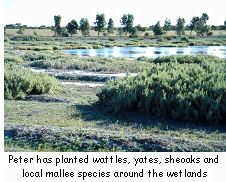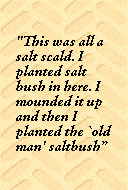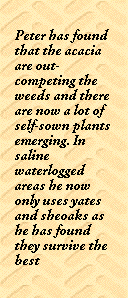
Peter Biven, Beaumont

|
Wetland Protection and Drainage
Peter Biven, Beaumont |
 |
 The Site
The Site
Peter and Kirsty Biven moved to their 1090 hectare farm on Karl Berg Road, Beaumont in 1977. The land had been cleared by a previous owner and had regenerated. The Bivens re-cleared the paddocks and began developing them for sheep grazing and cropping. The property has numerous small wetlands dotted across it and in the early days after clearing the tractor used to become bogged in those that were cropped right through. Peter started putting in shelterbelts of trees in 1980 and since then he has been busy fencing some of the wetlands and planting trees and shrubs to use up the excess water. The Problem During 1989 the area experienced a major flood and Peter noticed that one of the lakes was showing the first signs of degradation from waterlogging. During this time he also noticed the beginnings of salt problems, "You see the evidence of salt a couple of months after these wet events, they can really show up. They come up just in the middle of the paddock". The salt also began spreading up the valley.
To try and alleviate the waterlogging and salinity problems Peter has planted wattles, yates, sheoaks and local mallee species around the wetlands. He did try sugar gums previously but they died when they became waterlogged. The family had an Arbor Day and put all the trees in using a hand planter. The areas were ripped six weeks before planting and Peter didn't pack down the soil down after ripping. The area was then sprayed for weeds using 'Roundup' and 'Simazine' and then the trees were planted six weeks later. He is pleased to see that his neighbours are also planting trees as he believes that this is helping with the waterlogging problems on his farm. In 1994 Peter planted saltbush on a bare salt scald area adjacent to a wetland. "This was all a salt scald. I planted salt bush in here. I mounded it up and then I planted the 'old man' saltbush. A drain goes right through the area to drain the water away into a lake. I did it with a grader and put soil on both sides to direct the water flow. If I hadn't put the drain in there it would be a huge lake. The saltbush is doing well on the salt scald and it will be grazed eventually". He is pleased with the 95% success rate of the saltbush despite the fact that it was planted during a drought. He noticed that after one year the prostrate type saltbush had grown to two to three metres across. He believes that in the areas that have been planted with saltbush the water table has been lowered and the clover is growing back.
Peter has found that the acacias are out-competing the weeds and there are now a lot of self-sown plants emerging. In saline waterlogged areas he now only uses yates and sheoaks as he has found they survive the best. Peter believes that he should have come out further with the fence around some of the wetlands, although he hasn't noticed the salt spreading any further. |
 |
|
 |
|
 |
|